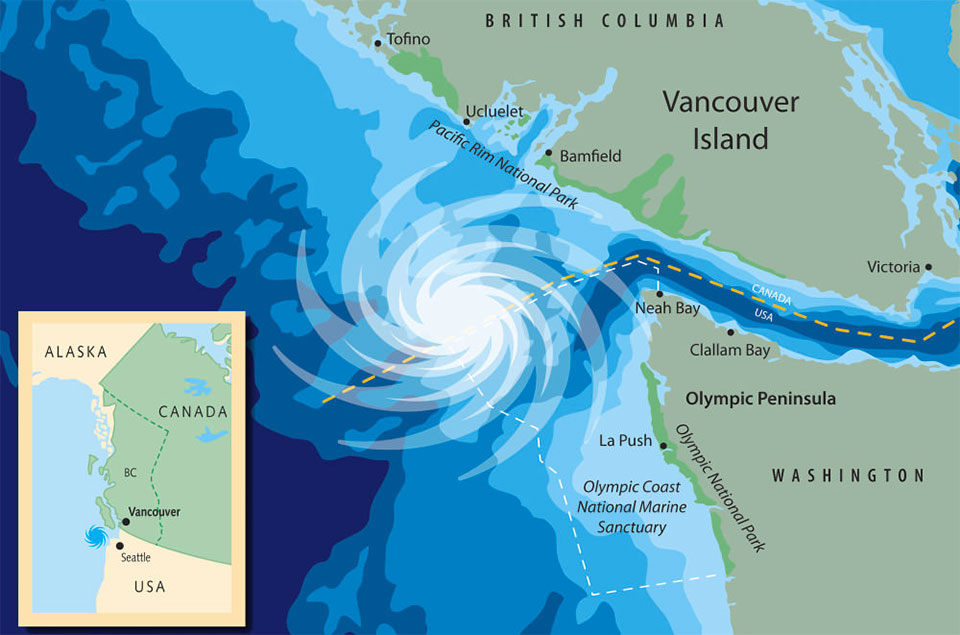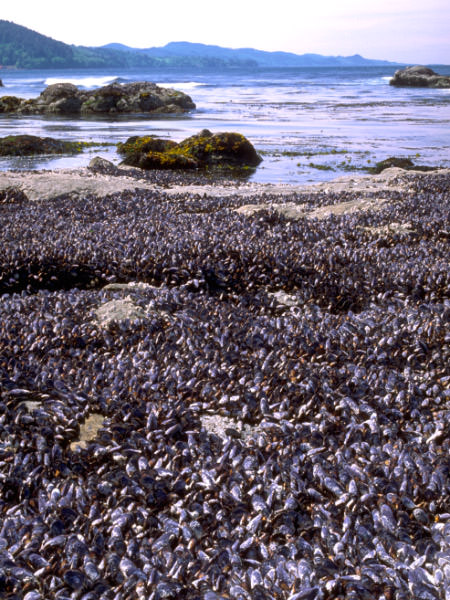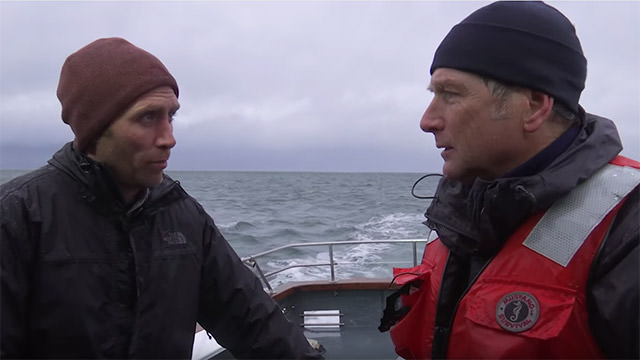Climate Change and Ocean Acidification
Olympic Coast

Why is it a concern?
Climate change emerged in recent decades as a theory and is now a broadly acknowledged phenomenon with impacts demonstrated around the world. In recent years, shellfish growers in Washington state have needed to develop monitoring and treatment practices to avoid spawning failures that have been linked to periodic upwelling of more acidic ocean waters. In the not-so-distant future, climate change is projected to profoundly impact coastal and marine ecosystems on a global scale, with anticipated effects on water quality, sea level, temperature, storm intensity and current patterns. At a regional scale, we can anticipate significant shifts in the distribution of species, seasonal flows in freshwater systems, cycles of primary productivity, coastal flooding and erosion, and wind-driven circulation patterns. A better understanding of oceanic ecosystem responses to climatic changes is needed to improve interpretation of observable ecosystem fluctuations, such as temperature variability, hypoxic events and upwelling of more acidic waters that may or may not be directly coupled to climate change.
Overview of Research
Research conducted by sanctuary scientists and partners provides critical information to address existing and emerging resource conservation and management issues. The Overview of Research highlights some, but not necessarily all, of the research activities completed or ongoing at the sanctuary.
| Project Name | PI and contacts | Links |
|---|---|---|
Climate Change and the OCNMS: Interpreting Potential Futures |
Ian Miller, Washington Sea Grant, and OCNMS |
http://sanctuaries.noaa.gov/science/conservation/pdfs/ocnms_cca.pdf |
Blue Ribbon Panel on Ocean Acidification |
Richard Feely et al. |
Scientific Summary of Ocean Acidification in Washington State Marine Waters |

Science Needs and Questions
The best available science is used by Sanctuary scientists and managers working to address priority resource conservation and management issues. As priorities change and new issues emerge, each Sanctuary develops new science needs and questions and works with partners to address them.
- To what extent are patterns of upwelling timing and intensity changing, perhaps as a result of climate change?
- How are any observed changes in oceanographic patterns linked to hypoxic events and harmful algae blooms?
- What affordable monitoring parameters and approaches can be implemented to measure real-time and predict aragonite and calcite saturation horizons?
- With species range shifts associated with warmer waters or other climate change-related factors, which species, if established in the sanctuary, are most likely to proliferate and alter existing ecological community structure?
Education and Outreach Material
Not Just Chemistry
Ocean acidification is about more than just water chemistry. Climb aboard with Philippe Cousteau as he talks with students, fishermen, and scientists, including Research Coordinator, Liam Antrim, to explore how the people of Washington's Olympic Coast are responding to changing marine ecosystems. Credit: EarthEcho International.
Office of National Marine Sanctuaries Climate Change Website
EarthEcho International: Shell Shocked
Understanding Ocean Acidification
Washington Sea Grant. 2014. Ocean Acidification in the Pacific Northwest
20 Facts about Ocean Acidification
NOAA Ocean Acidification Education Resources
NOAA PMEL Carbon Program Ocean Acidification Information
References
Gittings, S.R., M. Tartt, and K. Broughton. 2013. National Marine Sanctuary System Condition Report 2013. U.S. Department of Commerce, National Oceanic and Atmospheric Administration, Office of National Marine Sanctuaries, Silver Spring, MD. 33 pp.
Miller, I.M., C. Shishido, L. Antrim, and C.E. Bowlby. 2013. Climate Change and the Olympic Coast National Marine Sanctuary: Interpreting Potential Futures. Marine Sanctuaries Conservation Series ONMS-13-01. U.S. Department of Commerce, National Oceanic and Atmospheric Administration, Office of National Marine Sanctuaries, Silver Spring, MD. 238 pp.
Office of National Marine Sanctuaries. 2008. Olympic Coast National Marine Sanctuary Condition Report 2008. U.S. Department of Commerce, National Oceanic and Atmospheric Administration, Office of National Marine Sanctuaries, Silver Spring, MD. 72 pp.
Washington State Blue Ribbon Panel on Ocean Acidification. 2012. Ocean Acidification: From Knowledge to Action, Washington State’s Strategic Response. H. Adelsman and L. Whitely Binder (eds). Washington Department of Ecology, Olympia, Washington. Publication no. 12-01-015.
West Coast Ocean Acidification and Hypoxia Science Panel: Ocean Acidification and Hypoxia: Today’s Need for a Coast-Wide Approach. http://westcoastoah.org/wp-content/uploads/2014/10/Todays-Need-for-a-Coast-Wide-Approach-Oct2014.pdf
West Coast Ocean Acidification and Hypoxia Science Panel: Ocean Acidification and Hypoxia: Envisioning a Future Science Landscape. http://westcoastoah.org/wp-content/uploads/2014/06/EnvisioningFutureSciLandscape-2015.pdf


